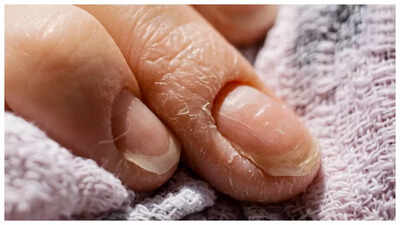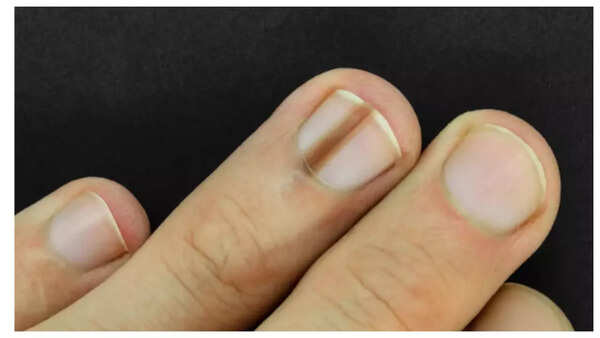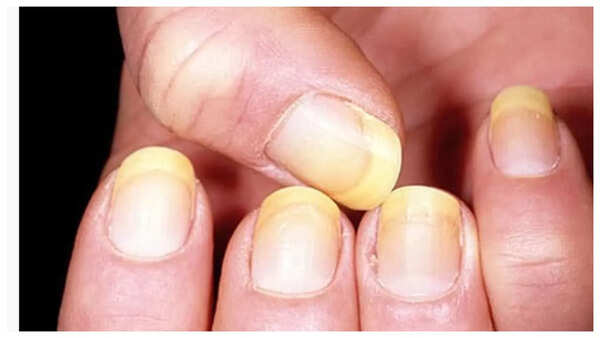10 hidden warnings that our nails give about the body’s health

Nails don’t just exist for aesthetic reasons or for applying cute polish. They act like tiny messengers, quietly hinting at what might be happening inside the body. Most of the time, they go unnoticed, unless chipped or broken. But every little line, colour change, or shape shift could carry meaning.Here’s what we need to understand about what the nails may be trying to say.
Dark vertical lines on nails
Dark vertical stripes, especially those that look like splinters, could mean vitamin B12 or vitamin D deficiency. These dark streaks, called melanonychia, may appear due to vitamin shortages, especially B12. Low vitamin D levels have also been linked. But in rare cases, such lines may hint at melanoma under the nail. Most often, they signal deficiency, but new or changing lines should be checked.

Tiny white spots or short white lines
Those little white dots could mean a lack of zinc. That’s partly true. Zinc deficiency has been linked to white spots, especially if there are other symptoms like low immunity or dry skin. Still, the majority of these spots are just tiny injuries to the nail matrix, often unnoticed when they happen.
Brittle, easily breakable nails
Often blamed on low biotin and calcium levels. Nails that split, peel, or snap might be crying for more biotin, a B-complex vitamin crucial for strong nails. Calcium also plays a role in nail structure. But let’s not forget lifestyle factors like frequent washing, harsh nail products, and even dry weather, which can worsen brittleness.
Yellowing of nails
Yellow nails often signal a fungal infection or the impact of smoking. Fungal infections are a top cause. The nails may become thicker, discoloured, and slow-growing. Smokers, too, may develop this yellowish hue. However, persistent yellowing may occasionally point to respiratory issues or diabetes, so it deserves attention.

Yellow nails are often caused by a fungal infection, especially if the nails become thick, brittle, or start to crumble.
Fully white nails with no pink base
A sign of liver or kidney issues. When nails lose their pinkish base and turn completely white, except for a thin pink band near the tip, it’s called Terry’s nails. It has been associated with liver cirrhosis, kidney failure, and even congestive heart issues. While it can also come with ageing, it’s not something to ignore if new.
Clubbed or bulged fingertips
Suggests poor oxygen supply. Clubbing is when nails curve downward and fingertips appear puffy. This can be a quiet signal of low oxygen in the blood. It’s been seen in people with chronic lung conditions like bronchitis, heart problems, or even liver disease. Often slow to develop, but crucial to investigate.
Pitted or dented nails
Nails with tiny dips may hint at skin conditions like eczema or psoriasis.Nail pitting, those small pin-like indentations, is strongly linked with psoriasis and sometimes alopecia areata. It’s more than skin deep. These dents may appear even before visible skin flare-ups and can serve as early markers of autoimmune conditions.
Bluish or purplish nails
May indicate poor blood circulation or low oxygen levels. A bluish tint in nails (especially when fingers feel cold) is a possible sign of low blood oxygen levels. This may happen during asthma attacks, in people with COPD, or due to certain heart issues. It could also simply be the body reacting to cold, but if persistent, it needs attention.
Spoon-shaped nails (koilonychia)
Most commonly seen in people lacking iron. Nails that dip inward and form a spoon-like curve often point to iron-deficiency anaemia. They’re not just a cosmetic concern. Sometimes, they also appear in people with hemochromatosis or celiac disease. Restoring iron levels can often improve nail shape over time.
Vertical ridges along the nail length
Usually harmless, but sometimes linked to iron deficiency.Fine vertical ridges can be a normal sign of ageing. But deeper or more defined ridges, especially when paired with pale or brittle nails, may suggest iron deficiency. These changes often progress slowly, which is why they may go unnoticed for a long.[This article is for informational purposes only and not a substitute for medical advice. Nail changes may reflect health conditions, but they are not diagnostic on their own. Always consult a doctor or dermatologist for any concerns.]






